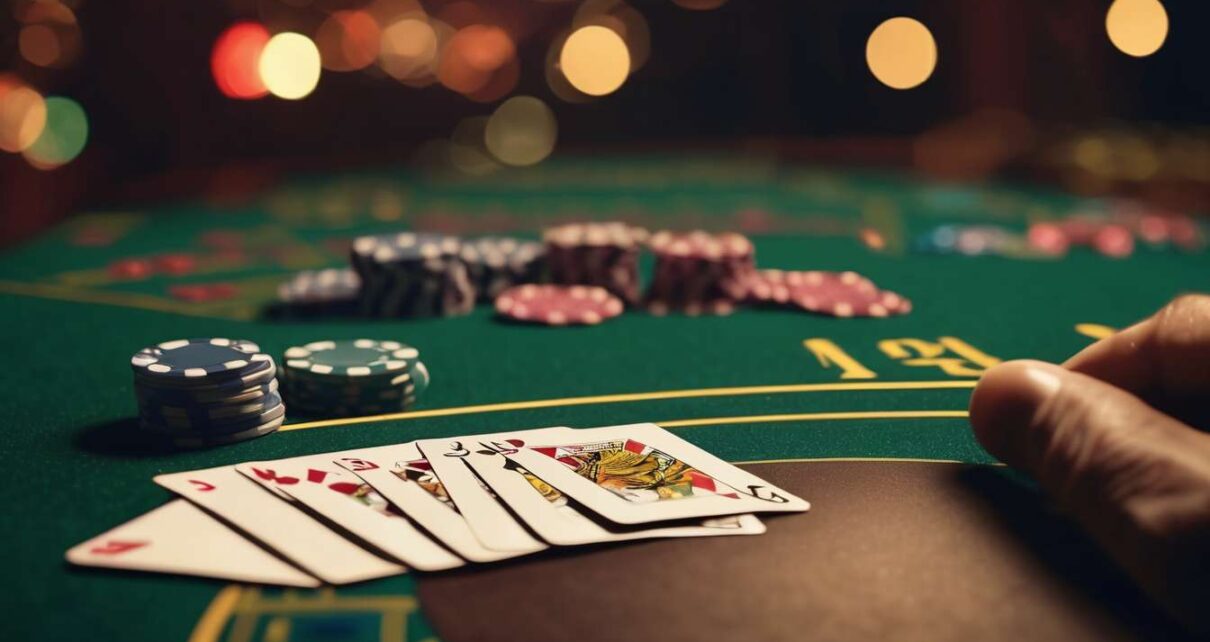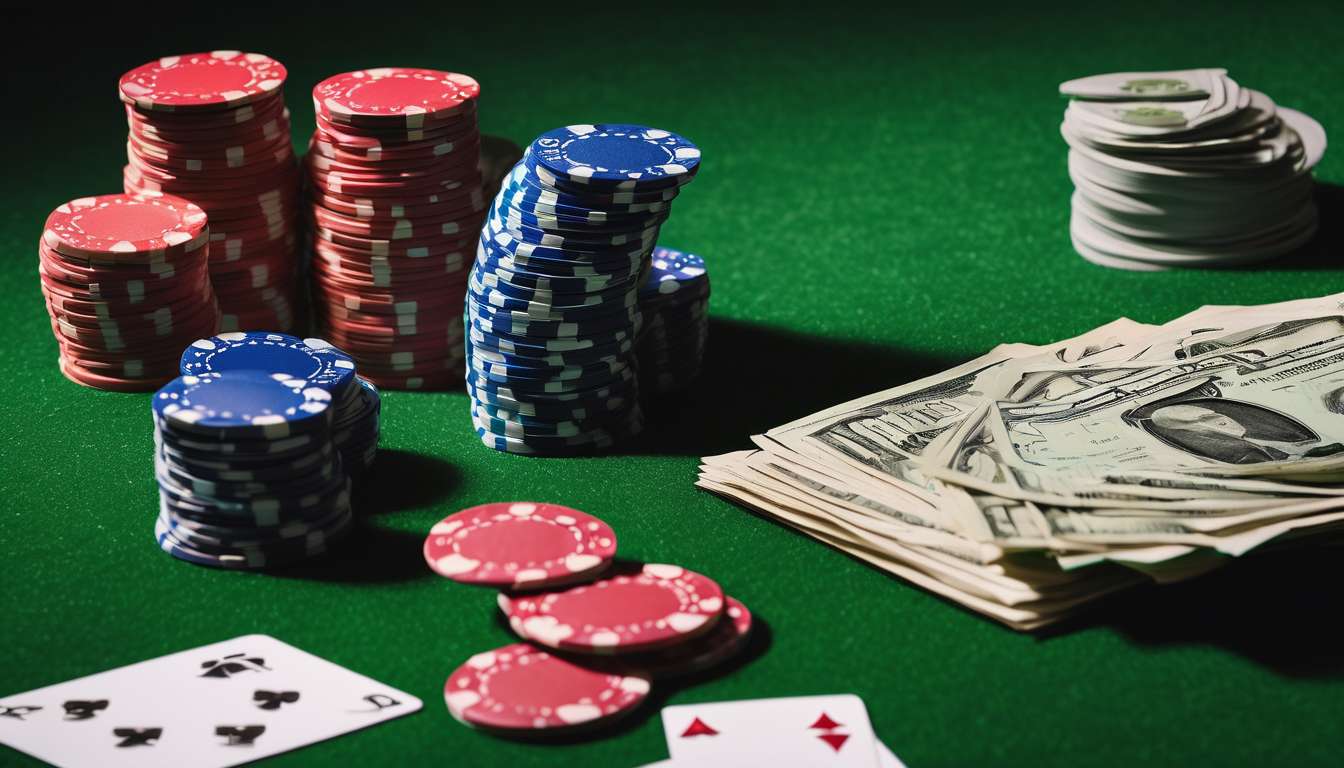When we first decided to explore the world of blackjack, we quickly realized that winning wasn’t just about luck; it required skill and strategy.
As a group of enthusiasts eager to master the game, we knew we needed more than just a basic understanding of the rules. That’s when we discovered the power of an effective strategy card. By using this tool, we could make informed decisions at the table and significantly increase our chances of winning.
Together, we delved into the intricacies of the game, analyzing probabilities and learning when to:
- Hit
- Stand
- Double down
- Split
With each hand we played, our confidence grew, and our losses diminished.
Our collective journey into the depths of blackjack strategy was not only educational but also exhilarating.
In this article, we aim to share our insights and experiences, hoping to empower fellow players to elevate their game with the same strategic approach.
Understanding the Strategy Card Basics
A strategy card is an essential tool that helps us make optimal decisions in any given blackjack situation. It acts like a wise friend, guiding us through the complexities of the game. With a blackjack strategy card in hand, we can feel more confident as it offers clear advice on how to proceed based on both our hand and the dealer’s visible card.
It’s not just about luck anymore; we’re making informed choices, and that feels empowering.
Understanding the Basics of a Blackjack Strategy Card:
-
The card presents a grid of possibilities, each cell offering a suggestion for a specific scenario.
-
It’s straightforward yet powerful, helping us reduce the house edge and improve our odds.
By using this tool, we’re not just playing; we’re strategizing as part of a knowledgeable community. This understanding brings us closer to the heart of the game and aligns us with fellow enthusiasts who appreciate precision and skill.
Deciphering the Hit or Stand Dilemma
Deciding whether to hit or stand is one of the most critical choices we face in a game of blackjack, and it significantly impacts our chances of winning. This decision is where our blackjack strategy card becomes our trusted ally, guiding us through every hand with precision.
Understanding when to hit or stand aligns us with proven strategies, enhancing our sense of belonging in the community of skilled players.
Our strategy card provides us with clear guidelines, taking into account:
- The dealer’s visible card
- Our own hand
For instance, when holding a hand totaling 16 against a dealer’s 10, our instincts might urge us to stand, fearing a bust. However, the strategy card often advises a hit, optimizing our odds.
Embracing this tool helps us make informed decisions, transforming uncertainty into confidence.
Together, using the card, we can navigate the hit or stand dilemma, ensuring we’re part of the winning circle.
Doubling Down for Success
Doubling Down in Blackjack
Doubling down can significantly boost our winnings when used strategically and at the right moments. By doubling our bet and receiving just one more card, we amplify our potential returns. However, it’s crucial we rely on our blackjack strategy card to determine when this bold move is in our favor.
When to Double Down
These strategy cards offer guidance, especially when:
- The dealer shows a weak card.
- We hold a promising hand like a 9, 10, or 11.
Informed Decisions and Community
We’re not just gambling; we’re making informed decisions and sharing in the camaraderie of fellow blackjack enthusiasts. Together, we can confidently double down, knowing we’re maximizing our chances for success. Our strategy card is more than a tool; it’s a shared roadmap to winning.
Opportunity, Not Guarantee
Let’s remember, doubling down isn’t a guarantee, but rather an opportunity to seize the moment when the odds align. As a community, understanding when to double down can foster our collective growth and success at the blackjack table.
Mastering the Art of Splitting
Splitting pairs in blackjack is a strategic move that can transform a weak hand into a winning opportunity. When faced with two identical cards, players can split them into separate hands, effectively doubling their chances of beating the dealer.
Using a blackjack strategy card helps determine the best moments to split, ensuring decisions are based on mathematics rather than guesswork. Understanding when to split is crucial in the journey to master blackjack. Pairing this knowledge with a strategy card boosts confidence at the table and enhances one’s sense of belonging in the blackjack community.
Key Splitting Strategy:
- Always split aces and eights. This is considered a golden rule as it maximizes potential gains and minimizes losses.
Community and Camaraderie:
- Learning these strategies together fosters camaraderie among players.
- Equipped with a strategy card, players can tackle the game with unity and skill.
- This shared knowledge turns challenges into triumphs and strengthens bonds with fellow players.
Leveraging Soft Hands for Advantage
Leveraging soft hands in blackjack allows us to exploit the flexibility of an ace to increase our chances of securing a win.
When we hold a soft hand, like an ace and a six, the ace can adapt its value, acting as either a one or an eleven. This adaptability offers us a strategic edge, letting us make bolder moves without the fear of busting.
By consulting our trusty blackjack strategy card, we can decide when to:
- Hit
- Stand
- Double down
This helps in maximizing our potential gains.
In our community of blackjack enthusiasts, understanding the nuances of soft hands fosters a sense of camaraderie and collective success. We thrive on shared strategies and insights, always eager to see each other succeed.
With the blackjack strategy card as our guide, we confidently navigate the game’s challenges, knowing when to take calculated risks. Together, we harness the power of soft hands, turning potential pitfalls into opportunities for victory.
Unveiling the Secrets of Insurance
Many players are intrigued by the insurance bet, a controversial yet strategic option in blackjack that can safeguard against the dealer’s potential blackjack. When the dealer shows an Ace, there’s a temptation to protect one’s hand by taking insurance. However, it’s crucial to understand how this fits into an overall blackjack strategy card.
Our community of blackjack enthusiasts aims to make informed decisions at the table. Taking insurance involves:
- Placing a side bet up to half the initial wager
- Paying 2:1 if the dealer has blackjack
While this sounds protective, the odds aren’t in our favor long-term.
Our strategy card typically advises against taking insurance since the dealer’s blackjack probability is less than one in three. Instead, we focus on decisions that maximize our advantage over time.
By trusting our strategy card, we strengthen our connection with fellow players who prioritize skill over chance. Mastering the art of ignoring insurance can elevate our game and enrich our shared blackjack journey.
Combating Common Blackjack Myths
In our quest to master blackjack, let’s debunk a few pervasive myths that often mislead players.
First, many believe that blackjack is purely a game of luck. While luck plays a role, using a blackjack strategy card helps us make informed decisions, increasing our chances of winning.
Another common misconception is that we’re due for a win after a series of losses.
- In reality, each hand is independent, and past outcomes don’t influence future results.
Some players think card counting is illegal.
- It’s not against the law, but casinos frown upon it.
- However, a well-used blackjack strategy card can be just as powerful for those of us who prefer to play within the rules.
Lastly, the myth that more players at the table reduces our odds isn’t true.
- The game’s odds remain consistent, whether we’re playing solo or with others.
By understanding these myths, we can better connect with fellow players and enhance our blackjack experience.
Fine-Tuning Your Card Counting Skills
To elevate our blackjack game, we’ll need to refine our card counting techniques for sharper decision-making at the table. It’s not just about keeping track of numbers; it’s about feeling connected to the rhythm of the game and understanding how each card dealt influences the odds.
Our blackjack strategy card serves as our trusty guide, but to truly master the game, we must enhance our counting skills.
Let’s focus on the Hi-Lo system, a popular method that assigns values to cards, helping us predict the likelihood of high or low cards appearing next. By practicing this system, we’ll be more in tune with the game’s flow, allowing us to adjust our bets strategically.
Steps to master the Hi-Lo system:
-
Assign Values:
- Cards 2-6: +1
- Cards 7-9: 0
- Cards 10-Ace: -1
-
Keep a Running Count:
- Add or subtract the values as cards are dealt.
-
Convert to a True Count:
- Divide the running count by the number of decks remaining.
-
Adjust Bets:
- Increase bets when the true count is high (favoring the player).
- Decrease bets when the true count is low (favoring the dealer).
It’s essential to practice in a supportive environment, where we share insights and grow together as a team.
Within our community, we learn from one another, sharpening our skills and building confidence. With dedication and practice, our collective card counting prowess will flourish, making us formidable at the blackjack table.
What role does table etiquette play in effective blackjack strategy?
Table Etiquette in Blackjack
Table etiquette in blackjack is crucial for effective gameplay. It impacts the flow of the game, our interactions with others, and even the dealer’s mood. Politeness and respect create a positive atmosphere, leading to better concentration and decision-making.
Key Etiquette Rules:
-
Do Not Touch the Cards or Chips:
- Only the dealer should handle the cards and chips once bets are placed.
-
Avoid Giving Unsolicited Advice:
- Offering advice to other players can be disruptive and is generally unwelcome.
-
Refrain from Disruptive Behavior:
- Keep conversations at a respectful volume and avoid any actions that might distract others.
By adhering to these etiquette rules, you can enhance your overall experience and maximize your chances of success at the blackjack table.
How does the number of decks in play affect the effectiveness of a strategy card?
When we consider the number of decks in play, it significantly impacts how effective a strategy card can be.
Effects of More Decks:
- More decks make card counting harder.
- Adjustments to gameplay are required.
- Probabilities are affected, altering strategy effectiveness.
It’s crucial to understand how the number of decks affects probabilities and adapt our strategy accordingly.
By recognizing these nuances, we can make more informed decisions and improve our chances of success at the blackjack table.
What are the psychological aspects of playing blackjack that can impact decision-making?
When we play blackjack, the psychological aspects can greatly influence our decision-making.
Emotions like excitement or anxiety may lead us to:
- Take risks
- Play more conservatively
Being aware of our own tendencies and maintaining a calm mindset can help us make better choices at the table.
It’s essential to:
- Stay focused
- Not let emotions cloud our judgment
These steps are crucial when playing this strategic game.
Conclusion
Now that you’ve delved into the world of blackjack strategy cards, you’re well-equipped to conquer the tables with confidence.
Key Points to Remember:
-
By understanding the basics, you lay the foundation for effective gameplay.
-
Mastering key decisions such as hitting or standing is crucial for making informed choices during the game.
-
Utilizing advanced techniques like doubling down and splitting can significantly enhance your chances of winning.
Practice Makes Perfect:
- Keep honing your skills through regular practice.
- Fine-tune your strategy based on your experiences and outcomes.
- Stay updated with any new strategies or changes in the game dynamics.
Good luck at the tables, and remember that consistent practice and strategic thinking are your best allies in becoming a blackjack pro!




